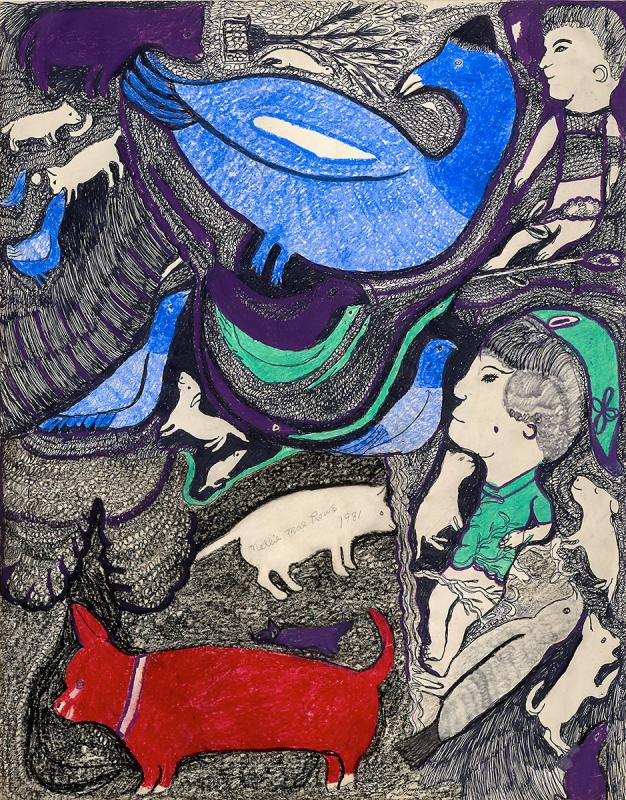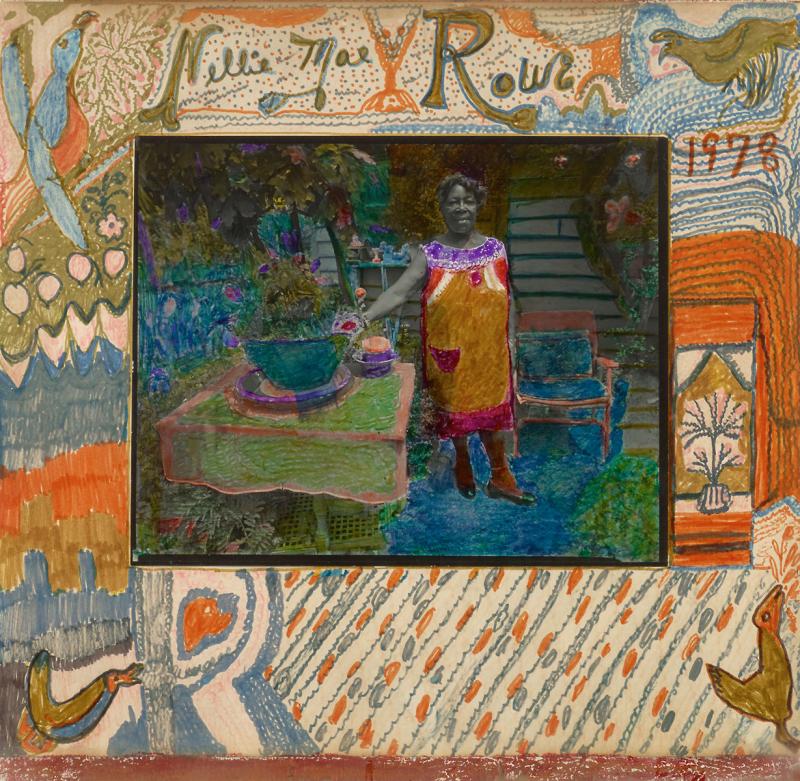In this unwelcome new age of social distance and self-isolation, when many of us hardly venture beyond the thresholds of our homes, I find myself thinking about Nellie Mae Rowe’s “playhouse.”
Rowe (1900–1982) was born in Fayetteville, Georgia, at the dawn of the twentieth century. Like many self-taught artists, she came late to art, taking it up in earnest only when she was forty-eight. She made exuberant, non-hierarchical drawings of animals and people, using pastels, crayons, and ballpoint or felt-tip pens to fill sheets from edge to edge. She also made dolls and found-object assemblages, which she displayed in her home and in the elaborately decorated yard for which she became known. She referred to the house and yard collectively as her “playhouse.” An obituary published in the November/December 1982 issue of ART PAPERS described the yard as follows: “In the early days, a cobbled pathway of bottle caps led through a garden of earthly delights. Life-size dolls looked down from fence-posts; plastic fruit, Christmas ornaments, toys and transformed objects hung from the chinaberry trees. When the front gate to her small garden slammed, you realized that you were inside one of Nellie’s drawings.”

Nellie Mae Rowe (1900–1982), Untitled (Woman Talking to Animals), 1981. Ballpoint pen, felt-tip pen, crayon, pastel, and pencil on paper, 24 x 19 inches (61 x 48.3 cm). The Morgan Library & Museum, Gift of the Souls Grown Deep Foundation from the William S. Arnett Collection and purchase on the Manley Family Fund, 2018.101. © 2018 Estate of Nellie Mae Rowe / Artists Rights Society (ARS), New York. Photography Stephen Pitkin/Pitkin Studio.

Nellie Mae Rowe (1900–1982), Untitled, 1978. Felt-tip pen and black-and-white photograph on paper, 14 1/2 x 14 3/4 inches (36.8 x 37.5 cm). The Morgan Library & Museum, Gift of the Souls Grown Deep Foundation from the William S. Arnett Collection and purchase on the Manley Family Fund, 2018.100. © 2018 Estate of Nellie Mae Rowe / Artists Rights Society (ARS), New York. Photography Stephen Pitkin/Pitkin Studio.
In a small mixed-media work (one of two drawings by Rowe that the Morgan acquired in 2018), she is seen at the center of the composition, posing for a photograph in her playhouse. Black-and-white photography being obviously ill-suited to the representation of a place so filled with joy and life, Rowe remedied the photo, almost entirely obscuring the gray tones with felt-tip pen markings in a riot of colors, and set it in the center of a larger sheet, which resembles a decorative frame. In her candy-colored dress, Rowe looks like a paper doll.
Rowe’s playhouse was, by all accounts, extraordinary, but it was also part of a long tradition of “yard shows” or “dressed yards.” In her article “Tradition and Innovation in African-American Yards,” published in African Arts, anthropologist Grey Gundaker summarizes the practice of yard work as follows: “Across the United States, and especially in the South, some African Americans decorate, dress, or work their yards using a flexible visual vocabulary that creolizes and revitalizes American, European, and African traditions through everyday materials—tires, stones, twine, pinwheels, plumbing, planters, toys, and auto parts.” Dressed yards serve a variety of functions: in addition to pleasing their creators, they may act as a protective space, mediating between the home and the world outside—reflecting the fact that for much of the twentieth century, African Americans in the South had good reason to feel threatened. Trees decorated with light bulbs, tin pans, or glass jars are an improvised form of the traditional bottle tree, which originated in Africa. The reflective materials are thought to attract positive spirits and to repel malevolent ones. “Special chairs,” or chairs that are clearly not meant to be used by visitors, may serve as memorials or tributes to ancestors.
In a period of unprecedented isolation, the idea of home as a rich and multivalent playhouse is appealing. Being stuck at home might open our eyes to souvenirs, trinkets, photos, and arrangements of objects we stopped noticing long ago, or buried out of sight. All of the qualities that attract assemblage artists to “found” objects are present in our own objects—memories, histories, and, in certain combinations, symbolic or spiritual meanings. For the time being, we can revel in our own playhouses; what choice to we have? But we might also look ahead to the time when we can share our homes with friends and family once again. After all, Rowe didn’t cultivate her garden only for herself. As the author of her obituary fondly recalled, “I don’t think Nellie Mae Rowe ever turned anybody away from her door. Even during the last year when she was ill, she would open her door, saying: ‘I’m weak, baby, but come on in and sit down.’”
Rachel Federman
Associate Curator
Modern and Contemporary Drawings
